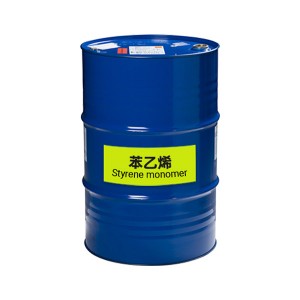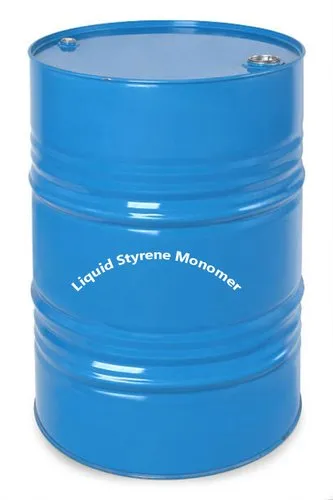-

styrene liquid
CAS No.:100-42-5
HS code:29025000
Other Names:styrene
- MF:C8H8
- EINECS No.:202-851-5
- Place of Origin:Shandong, China
- Grade Standard:Industrial Grade
- Purity:99.5%
- Appearance:colorless oily liquid
- Application:polystyrene
- Bases:A level≥99.5%;B level≥99.0%
- Melting point:-30.6℃
- Boiling point:146℃
- Relative density:0.91
- Relative vapor density:3.6
- Saturated vapor pressure:1.33(30.8℃)kPa
- Heat of combustion:4376.9kJ/mol
- Critical temperature:369℃
- Critical pressure:3.81MPa
-

styrene for ABS resin
CAS No.:100-42-5
HS code:29025000
Other Names:styrene
- MF:C8H8
- EINECS No.:202-851-5
- Place of Origin:Shandong, China
- Grade Standard:Industrial Grade
- Purity:99.5%
- Appearance:colorless oily liquid
- Application:polystyrene
- Bases:A level≥99.5%;B level≥99.0%
- Melting point:-30.6℃
- Boiling point:146℃
- Relative density:0.91
- Relative vapor density:3.6
- Saturated vapor pressure:1.33(30.8℃)kPa
- Heat of combustion:4376.9kJ/mol
- Critical temperature:369℃
- Critical pressure:3.81MPa
-

styrene used to produce polystyrene resins
CAS No.:100-42-5
HS code:29025000
Other Names:styrene
- MF:C8H8
- EINECS No.:202-851-5
- Place of Origin:Shandong, China
- Grade Standard:Industrial Grade
- Purity:99.5%
- Appearance:colorless oily liquid
- Application:polystyrene
- Bases:A level≥99.5%;B level≥99.0%
- Melting point:-30.6℃
- Boiling point:146℃
- Relative density:0.91
- Relative vapor density:3.6
- Saturated vapor pressure:1.33(30.8℃)kPa
- Heat of combustion:4376.9kJ/mol
- Critical temperature:369℃
- Critical pressure:3.81MPa
-

styrene for EPS
CAS No.:100-42-5
Other Names:styrene
- MF:C8H8
- EINECS No.:202-851-5
- Place of Origin:Shandong, China
- Grade Standard:Industrial Grade
- Purity:99.5%
- Appearance:colorless oily liquid
- Application:polystyrene
- Bases:A level≥99.5%;B level≥99.0%
- Melting point:-30.6℃
- Boiling point:146℃
- Relative density:0.91
- Relative vapor density:3.6
- Saturated vapor pressure:1.33(30.8℃)kPa
- Heat of combustion:4376.9kJ/mol
- Critical temperature:369℃
- Critical pressure:3.81MPa
-

styrene monomer for EPS production
CAS No.:100-42-5
Other Names:styrene
- MF:C8H8
- EINECS No.:202-851-5
- Place of Origin:Shandong, China
- Grade Standard:Industrial Grade
- Purity:99.5%
- Appearance:colorless oily liquid
- Application:polystyrene
- Bases:A level≥99.5%;B level≥99.0%
- Melting point:-30.6℃
- Boiling point:146℃
- Relative density:0.91
- Relative vapor density:3.6
- Saturated vapor pressure:1.33(30.8℃)kPa
- Heat of combustion:4376.9kJ/mol
- Critical temperature:369℃
- Critical pressure:3.81MPa
-

styrene for Acrylonitrile Butadiene Styrene
styrene for Acrylonitrile Butadiene Styrene, ABS Raw Material, Styrene For ABS Resin, styrene used for manufacture ABS, Styrene Used For Plastics, ABS has good chemical and stress-cracking resistance to inorganic salt solutions, alkalies, mineral acids (except strong oxidizing acids), and some mineral, vegetable, and animal oils. ABS is easily machined to close tolerances, is tough, dimensionally stable, and may also be thermoformed. Petroleum-based oils, solvents, and paints SHOULD NOT BE US... -

styrene for PS
CAS No.:100-42-5
Other Names:styrene
- MF:C8H8
- EINECS No.:202-851-5
- Place of Origin:Shandong, China
- Grade Standard:Industrial Grade
- Purity:99.5%
- Appearance:colorless oily liquid
- Application:polystyrene
- Bases:A level≥99.5%;B level≥99.0%
- Melting point:-30.6℃
- Boiling point:146℃
- Relative density:0.91
- Relative vapor density:3.6
- Saturated vapor pressure:1.33(30.8℃)kPa
- Heat of combustion:4376.9kJ/mol
- Critical temperature:369℃
- Critical pressure:3.81MPa
-

Liquid Styrene Monomer
CAS No.:100-42-5
Other Names:styrene
- MF:C8H8
- EINECS No.:202-851-5
- Place of Origin:Shandong, China
- Grade Standard:Industrial Grade
- Purity:99.5%
- Appearance:colorless oily liquid
- Application:polystyrene
- Bases:A level≥99.5%;B level≥99.0%
- Melting point:-30.6℃
- Boiling point:146℃
- Relative density:0.91
- Relative vapor density:3.6
- Saturated vapor pressure:1.33(30.8℃)kPa
- Heat of combustion:4376.9kJ/mol
- Critical temperature:369℃
- Critical pressure:3.81MPa
-

styrene for ABS resin
CAS No.:100-42-5
Other Names:styrene
- MF:C8H8
- EINECS No.:202-851-5
- Place of Origin:Shandong, China
- Grade Standard:Industrial Grade
- Purity:99.5%
- Appearance:colorless oily liquid
- Application:polystyrene
- Bases:A level≥99.5%;B level≥99.0%
- Melting point:-30.6℃
- Boiling point:146℃
- Relative density:0.91
- Relative vapor density:3.6
- Saturated vapor pressure:1.33(30.8℃)kPa
- Heat of combustion:4376.9kJ/mol
- Critical temperature:369℃
- Critical pressure:3.81MPa
-

Acrylonitrile for NBR
The acrylonitrile is a colorless to pale yellow liquid and volatile liquid that is soluble in water and most common organic solvents such as acetone, benzene, carbon tetrachloride, ethyl acetate, and toluene. Acrylonitrile is produced commercially by propylene ammoxidation, in which propylene,ammonia, and air are reacted by catalyst in a fluidized bed. Acrylonitrile is used primarily as a co-monomer in the production of acrylic and modacrylic fibers. Uses include the production of plastics, surface coatings, nitrile elastomers, barrier resins, and adhesives. It is also a chemical intermediate in the synthesis of various antioxidants, pharmaceuticals, dyes, and surface-active.
-
Acrylonitrile for Acrylonitrile Butadiene Rubber
Acrylonitrile for Acrylonitrile Butadiene Rubber, Acrylonitrile For NBR, Acrylonitrile For Nitrile Rubber, NBR, Buna-N, and nitrile all represent the same elastomer based on a butadiene and acrylonitrile copolymer. Nitrile is inherently resistant to hydraulic fluids, lubricating oils, transmission fluids and other non-polar petroleum based products due to the polar structure of this elastomer. Nitriles are also resistant to air and water environments. Product Features Product Name Acryloni... -

Acrylonitrile for NBR
The acrylonitrile is a colorless to pale yellow liquid and volatile liquid that is soluble in water and most common organic solvents such as acetone, benzene, carbon tetrachloride, ethyl acetate, and toluene. Acrylonitrile is produced commercially by propylene ammoxidation, in which propylene,ammonia, and air are reacted by catalyst in a fluidized bed. Acrylonitrile is used primarily as a co-monomer in the production of acrylic and modacrylic fibers. Uses include the production of plastics, surface coatings, nitrile elastomers, barrier resins, and adhesives. It is also a chemical intermediate in the synthesis of various antioxidants, pharmaceuticals, dyes, and surface-active.

